1D Hydraulic Modelling
Hydrodynamic Modelling using HEC-RAS
Pages: Assignment - Part 1 - Part 2
Part 1: set-up and analysis of a simple channel model
This page describes the 1st part of the 3rd assignment.
The 1st part of the assignment deals with a simple channel model as
preparation for more complex modelling tasks in part2. This page
describes the main steps to update a basic steady HEC-RAS
model similiar as used in assignment 2 towards a first unsteady model.
The main steps to set-up such HEC-RAS model are described in the related
tutorial
of assignment 2.
Basic steady model properties:
- homogeneous channel of 5000m length
- prismatic rectangular cross section of 50m width and 10m height
- known water surface elevation upstream and downstream: 4 m
- estimated channel roughness of 30 (Strickler) / 0.0333 (Manning).
- no slope
- no weir
Step 1: Basic steady HEC-RAS model
Please download the basic steady model from the course server:
Extract the model to a new folder.
Run the steady simulation and analyse the results by physical interpretation.
Step 2: Set-up 1st unsteady model
Please create a unsteady simulation for the basic model.
- same geometry as the steady model
- same channel roughness as the steady model
- simulation window: 2 hours with 1 minute time step
- initial conditions: no flow, constant water level of 4 m
- boundary conditions: upstream known water level h(t) = 4 m
- boundary conditions: downtream known discharge q(t) = 0 m3/s (no flow, vertical wall)
| step
| action/screenshot
thumbnails with links to full size images
|
| remark
|
| 1.
| start HEC-RAS
project form:
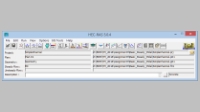
|
| open the basic steady model file SimpleChannel.prj
|
| 2.
| open and edit
Unsteady Flow Data
unsteady flow data form:
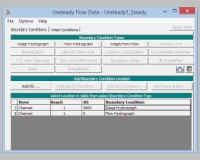
stage hydrograph form:
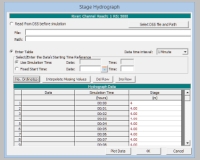
flow hydrograph form:
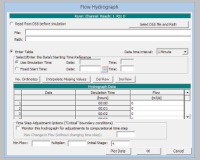
|
|
save the Plan in a new file with suitable name
always save the file after any change
select for the river station (RS) 5000 the boundary condition Stage Hydrograph
specify the stage in the table:
using a Data time interval of 1 Minute and No. Ordinates to 121 (-> 2 hours)
specify for the 1st and last Stage (m) value 4,
all other values can be interpolated by Interpolate Missing Values
select for the river station (RS) 0 the boundary condition Flow Hydrograph
specify the flow in the table:
using a Data time interval of 1 Minute and No. Ordinates to 121 (-> 2 hours)
specify for the 1st and last Flow (m3/s) value 0,
all other values can be interpolated by Interpolate Missing Values
set the Inital Stage as initial conditional to 4 m
|
| 3.
| perform the
Unsteady Flow Analysis
unsteady flow anlaysis form:

|
|
activate Geometry Preprocessor, Unsteady Flow Simulation and Post Processor
set Starting Time to 00:00
set Ending Time to 02:00
set Computation Interval (time step) to 1 Minute
set Hydrograph Output Interval to 1 Minute
keep Mapping Output Interval on a high value (e.g. 2 hours, we are not generating maps)
set Detailed Output Interval to 1 Minute
save the Plan in a new file with suitable name
finally run the simulation by the Compute button
|
| 4.
| analyse the results
hydrograph diagram:
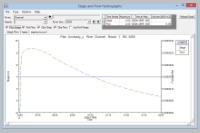
profile plot:
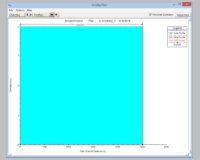
general profile:
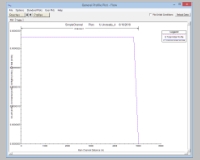
cross section table
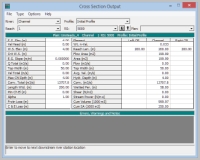
profile table:
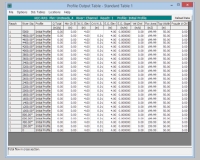
|
|
use Stage and Flow Hydrographs to analyse the h(t) and Q(t) time series upstream and downstream
use Water Surfave Profile to analyse the water surface in a longitudal profile h(x)
use General Profile to analyse the result values R in a longitudal profile R(x)
use Detailed Output Tables to get access to all relevant numbers for cross sections
use Detailed Output Tables to get access to all simulation numbers in time and space
|
|
| 5.
| initiate a wave
stage hydrograph:
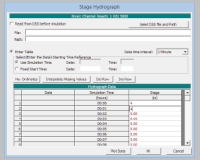
profile plot:
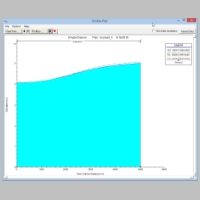
hydrograph diagram:
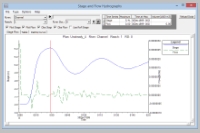
|
|
change the Stage Hydrograph upstream:
increase the water surface elevation after 2 min from 4 m to 5 m
analyse the results (step 4.) and specify the travel time of the wave from the result numbers
compare your result analytic insight from hydraulics
the speed of a gravity wave in shallow water is sqrt(g*h)
the time to run 5000 m is 5000 / sqrt(g*h)
for 4 m this is 5000 / sqrt(9.81*4) = 798 sec = 13,3 min
|
Step 3: Variation of the basic unsteady model
Please adapt your model with a variation of parameters.
- change the upstream water surface elevation from 4m/5m to 8m/9m (1m -> wave height)
this requires the change of the Stage Hydrograph and the Inital Stage value of the Flow Hydrograph
and
analyse the impact of the new water level ((8m)m instead of 4m )
to the travel time in the channel
- change the cross section width 50 m to other values (e.g. 20 m or 100 m)
and analyse the impact to the results (e.g. hydrograph diagram)
- change the calculation time step (1 sec, 10 sec, 5 min, 30 min)
and analyse the impact to the results (e.g. hydrograph diagram) using physical/numerical insight
- change the cross section distance to 50 m and 1000 m (XS interpolation)
and analyse the impact to the results (e.g. hydrograph diagram) using physical/numerical insight
Optional/Volountary additional variations of parameter:
- change the discharge at the boundary to introduce a basic velocity
- introduce a slope for the channel
- fix the water level and introduce a discharge time series
- change the bed resistance values
Step 4: Result Discussion
Please compare and discuss the results of the basic unsteady model as well as the four variations
with your expectations and the theory of open channel flow.
The comparison and discussion (interpretation) should consider:
- travel time of the wave to arrive at the other end of the channel
- water level time series at station 0, station 2500 and station 5000
- velocity and discharge time series at stations 0, 2500 and 5000
- max. water level at station 0 vs. station 5000
- numerical properties (e.g. time step, space step) of the model












